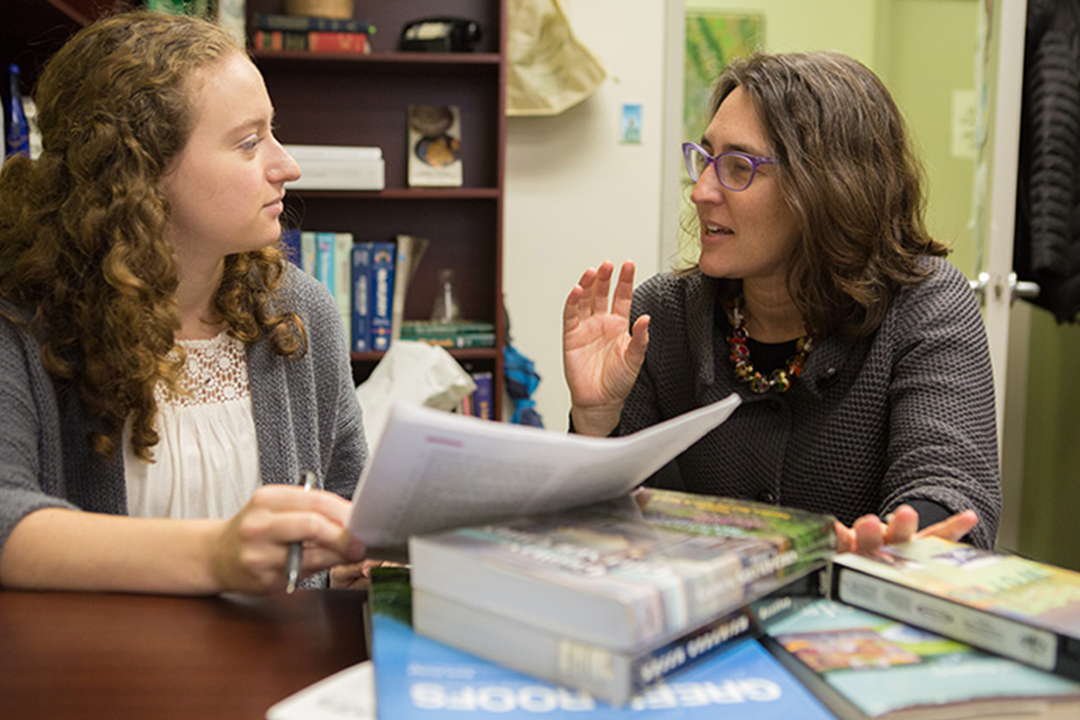By John DiConsiglio
Sydney Goldstein’s passion for urban planning and its impact on the environment led her to an incredible research opportunity—one that is enabling her to immerse herself in the latest policy trends involving green building heights. With the help of her faculty mentor, Assistant Professor of Geography and Public Policy Melissa Keeley, the Luther Rice Fellow is uncovering new data on the decisions behind the development and design of sustainable buildings.
“I was terrified when I started. It was literally the most intimidating thing I’d ever done,” said Goldstein, a senior majoring in environmental studies and dance. “But I’m the kind of person who loses herself in the research process. You get to a point where you forget about the fears, and you just see the facts and figures.”
For the past year, Goldstein has spent long hours combing through reams of raw data and stacks of literature reviews to chart green building trends across the United States. And the outcome of her effort isn’t just her Luther Rice Undergraduate Research Fellowship or a potential article on her findings for a peer review journal. Goldstein said the most surprising result is how much fun she’s having.
Growing Green Buildings
For the last decade, green building policies have caught on with cities around the country, particularly those with large populations, as a way to minimize the environmental impact of development. Buildings are one of the largest consumers of natural resources and account for a significant portion of greenhouse gas emissions. In the United States, buildings register nearly 40 percent of all CO2 emissions, 73 percent of electricity consumption and more than 13 percent of all potable water. According to the nonprofit U.S. Green Building Council, green buildings consume 25 percent less energy and 11 percent less water while accounting for 34 percent lower greenhouse gas emissions than traditional construction. This year, it is estimated that nearly half of all new nonresidential construction in the United States will meet green building goals.
When Goldstein first approached Keeley about examining the rise in green building policy over the last decade, her faculty mentor suggested looking at green buildings from an angle that had yet to be fully examined: the public policies behind how cities enact green building development. Keeley had already collected data focused on municipal decision making, but the cache of surveys and statistics needed to be analyzed and organized for a cohesive research study.
“Sydney stood out as a really driven student who was eager to engage in this material in great depth,” Keeley said. “I told her to have at it.”
Goldstein focused on data from 36 municipalities with populations ranging from as little as 50,000 to over two million. She dove into a comprehensive literature review of major documents on municipal green building, from environmental studies to city planning records. She divided her information into three areas: the green building decision-making process and the administrators behind those decisions; the information relied upon when making those decisions (case studies or leaders in the field, for example); and the degree that policy designs were localized.
“I haven’t seen anybody look at green building in the way Sydney approached it,” Keeley said. “The implications are broad. If we can understand what cities are trying to achieve through their green building policies and where they are getting their information, it puts us in a better place to support them.”
Instead of identifying which procedures worked better than others, Goldstein sought out policy trends. She noted the number and types of municipal offices that were involved in green building decision-making, such as departments of the environment, mayors’ offices and city councils. Also, she examined municipalities’ likelihood to turn to cities of similar size and geographic-locations as role models, emulating, for example, recognized leaders like Seattle, Portland and Chicago. However, Goldstein noted a tendency to localize those models, adapting them to specific concerns. A southwestern city, for example, might focus on water conservation, while coastal regions would dedicate additional resources to energy and pollution reduction. “Rarely does one city just copy another,” Goldstein said. “Usually they take a policy that worked well in a different city and shape it to fit their special circumstances.”
Goldstein credits Keeley with keeping her on course as she foraged through libraries resources and online databases. Her mentor was particularly helpful in framing and conceptualizing her research agenda to fit the topic parameters—narrow enough to be manageable but comprehensive enough to meaningfully add to the scientific record. “In research, you want to contribute in a novel way,” Keeley said. “You are building on the work of multiple scientists and researchers, but you can’t merely repeat what’s already been done.”
And Goldstein’s next step is—what else?—more research. “There’s always another document to read, another survey to compile,” she said. “Research work is never done."


